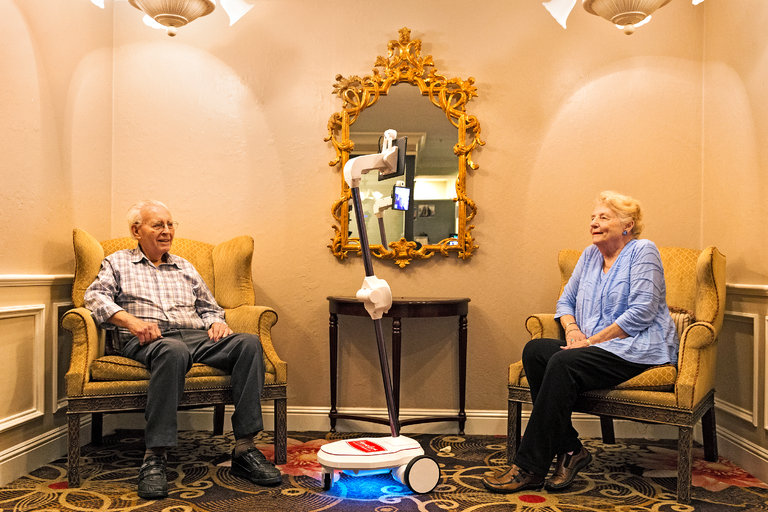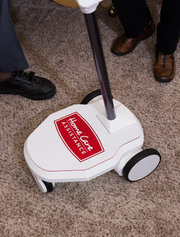By: Constance Gustke

Welcoming a robot into her family was never Maxine Duncan’s idea of a support aide in her older years. But this winter, she and her partner, Herbert Yarbrough, signed up to test a telepresence robot in their retirement community, the Heritage Downtown, in Walnut Creek, Calif. Their new pal has a screen for a head and scuttles around on wheels. The lure was being able to connect more easily with their families via video calls.
The couple were immediately smitten. They have named the robot Jimmy.
“It’s an easy name to remember,” said Ms. Duncan, 86, a former real estate broker. And Mr. Yarbrough, 89, takes the robot on the elevator to pick up breakfast downstairs.
“We want to keep up on technology,” said Ms. Duncan, who covets a self-driving car. “A lot of older people are isolated from people and ideas. Now we’re on the cutting edge.”
Rosie, the robot from “The Jetsons,” has arrived.
Early adopters like Ms. Duncan are on the front lines of testing new technologies that some experts say are set to upend a few of the constants of retirement. Eager not to be left behind, retirement communities are increasingly serving as testing grounds that vet winners and losers.
Some simple tools that can help older adults are already mass-market consumer items, like Amazon’s personal assistant, Alexa. Other inventions, such as virtual reality technologies and robotic limbs, are still in their early days but could soon provide more freedom, resources and constant care to retirees.
Virtual reality, for example, can entertain, educate and engage us, he said. “It’s for young and old alike,” Mr. Coughlin said. “And it’s enjoyed, not needed. That’s the high ground.” These devices will especially help augment the adult child’s caregiver role, he added.
Thuc Vu, co-founder of OhmniLabs, helped invent the robot Ohmni that is now Ms. Duncan and Mr. Yarbrough’s companion.
Dr. Vu, who has a Ph.D. in computer science from Stanford, sees consumer robotics as the next big technology wave. “There’s a huge senior population, but isolation and loneliness is still common,” he said. “And we’re also running out of caregivers, since most of them are getting older.”
The OhmniLabs robot was designed with the techno-averse in mind and requires limited computer knowledge. It’s connected to Wi-Fi and operated remotely. In its next iteration, the company is working on training the robot to pick up objects. “In five years, it will be able to wash dishes, do laundry and clean the house,” Dr. Vu said.
This year, OhmniLabs robots will be offered by a consumer health firm, Home Care Assistance, to retirement communities and people aging in place. The yearly cost is about 20 percent of the cost, on average, of hiring full-time caregivers, according to Lily Sarafan, chief executive of Home Care Assistance.

In five to seven years, caregiving will shift,” Ms. Sarafan said. “And a lot of home automation will become more mainstream.”
Digital health means more attention to senior care, said Ms. Sarafan, who is an active tech investor and a mentor at StartX. “Otherwise, aging is a huge challenge,” she added.
Older adults at Brookdale are eager to offer feedback, said Andrew Smith, the company’s director of strategy and innovation. And entrepreneurs also get firsthand experiences with an aging population that has to adapt to their ideas.
“Technology will change the way people age in America,” Mr. Smith said. “It’s going to drive every dimension of health or social isolation. Nursing homes were once where you’d go to die.”
Some devices miss their mark. Brookdale residents tested a body dryer, which is widely used at amusement parks to dry people after a ride. “But no one would come near it,” he said.
Virtual reality, however, has touched residents’ hearts. “Seniors were weeping to see their old homes again,” Mr. Smith said.
Virtual reality rejuvenated life for Abdus Shakur, 67, who lives in a Brookdale residence in Quincy, Mass. A classically trained chef, Mr. Shakur opted to take a virtual trip to a Creole restaurant in Berlin, where he once worked.
By wearing the V.R. headset, he could check out the current menu and look at the restaurant’s colorful redesign.
Mr. Shakur also took virtual trips to beaches in the Caribbean, where he felt the sand under his feet and saw schools of fish under water.
“I felt like I was right there,” said Mr. Shakur, who has a bad heart and doesn’t travel as much as he used to. “It gives you so much hope. I can sit in my living room and go all over the world.”

Mr. Shakur’s headset was developed by Rendever, after a co-founder’s mother-in-law’s dementia led to communication problems.
“So we’re using V.R. as a mechanism to enhance life,” said Dennis Lally, C.E.O. and co-founder of Rendever, an M.I.T. company based in Boston. The founders spent hundreds of hours living with residents in Massachusetts to understand their needs, and a crucial lesson was that they often talked about travel.
“Sensory stimulation is important,” Mr. Lally said. “And V.R. creates a sense of wonder for the world again.” Taking people back in time can even prompt more memories in people with cognitive impairments.
Changing ideas about aging are also affecting how products are branded, said Stephen Johnston, co-founder of the technology accelerator Aging2.0. Some, however, still have a learning curve, such as one start-up that used the word “grandparent” in its name. “But not every older person is a grandparent,” Mr. Johnston said.
Front Porch, which operates retirement communities in California, has been one of the most actively involved in trying out the devices, he said.
The company’s Center for Technology Innovation and Wellbeing has tested many products and has been able to provide feedback to inventors and marketers on what works. A robot baby seal named Paro, for example, helped people with dementia communicate, while virtual reality that stimulates the mind worked well, too.
This year, Front Porch will test ride-sharing services and Amazon Echo as part of the internet of things that can operate smart devices. “Echo can reach people who are visually impaired,” said Davis Park, director of the Front Porch Center for Innovation and Wellbeing. “And it can be interactive. It’s a form of companionship.”
Sara Carter, 82, who has had knee replacements and lives in a Front Porch community called Sunny View, tried the bionic leg. After walking back and forth with it, she said it was a useful tool.
“I’m interested in technology that helps people,” said Ms. Carter, who doesn’t own a smartphone. The bionic leg, which was later altered to be lighter and fit better, is now on the market.
Retirement communities can be the perfect proving grounds for such devices that will help an aging population, officials say.
“There has been a big problem with asking seniors about these products,” Mr. Park said. “We’re a bridge.”
Original article is from the New York Times.

